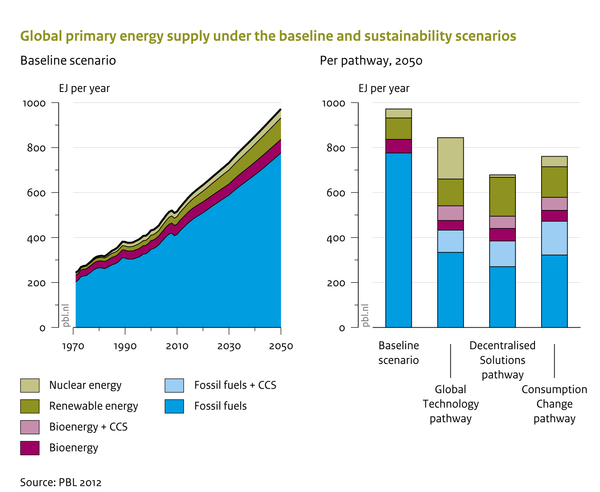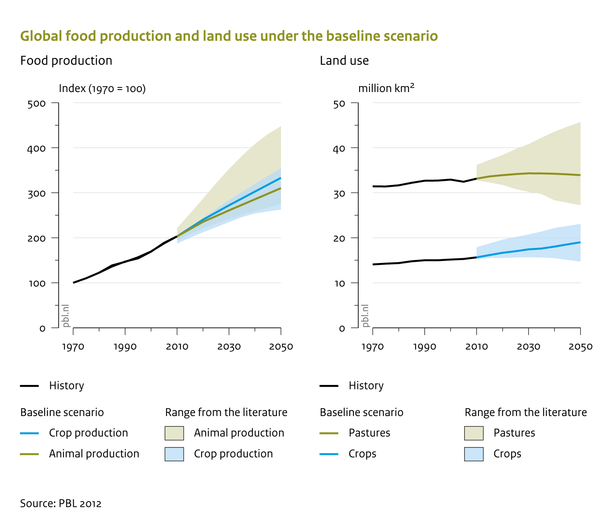IMAGE framework summary/Human system
| Projects/Applications |
| Relevant overviews |
| Key publications |
The Human system: Energy supply and demand and agricultural systems
Human activities that play a key role in environmental and sustainable development issue are energy use and supply (Component Energy supply and demand) and food consumption and supply (Component Agriculture and land use).
Energy demand and supply
The IMAGE framework uses the detailed energy system model “The IMage Energy Regional model” (TIMER) to describe the long-term dynamics of the energy system (Components Energy demand; Energy conversion; Energy supply). The model includes a description of demand for energy services and end-use energy carriers, and also describes the future role of fossil fuels versus alternative supply options, such as renewables and nuclear power to meet the demands.
The model determines demand for energy services with population and income as primary drivers and assumptions on lifestyle. Demand is met by final energy carriers, which are produced from primary energy sources. The mix of final energy carriers and the technologies to produce them are chosen on the basis of their relative costs. Key processes that determine these costs include technology development and resource depletion, and also preferences, fuel trade assumptions and policies.
The model output demonstrates how energy intensity, fuel costs and competing non-fossil supply technologies develop over time. Emissions mitigation is generally modelled on the basis of price signals. A carbon tax (used as a generic measure of climate policy) induces additional investment in energy efficiency, and in fossil-fuel substitution, bioenergy, nuclear power, solar power, wind power and carbon capture and storage. The energy model is linked to other parts of IMAGE via calculated emissions and demand for bioenergy production (generating input into the land use model).
Example: The model can be used to make detailed projections of the energy system, with and without climate policy. In the Rio+20 study, the baseline scenario without climate policy projects a 65% increase in energy consumption in the 2010-2050 period, driven by continued population and economic growth. With no fundamental change in current policies, fossil fuels are expected to retain a large market share as their market price is expected to remain below the price of alternative fuels for most applications. In climate policy scenarios, the inclusion of a carbon price leads to an increased share of alternative technologies and resources, such as carbon capture and storage, nuclear power and renewables (the figure below).
Food consumption and agriculture
Demand for and production of agricultural products are modelled by the soft-linked agro-economic models MAGNET or alternatively IMPACT (Component Agricultural economy). The IMAGE crop and land-use models supply information to MAGNET on land supply by region and changes in potential yields. MAGNET provides information on future agricultural production levels and intensity by region, matching regional demands through trade. MAGNET assesses production of agricultural products based on combinations of primary (land, labour, capital and natural resources) and intermediate production factors. For the livestock sector, IMAGE makes scenario-specific assumptions about livestock production in different systems (Component Livestock systems). A key purpose of the agro-economy model is to determine regional production levels and the associated yields and livestock efficiencies, taking into account changes in technology and biophysical conditions. An increase in demand for agricultural production can be met by land expansion (using the regional land supply curves) and/or intensification of land use and increasing yields. IMAGE 3.0 also calculates timber demand and forest management (Component Forest management).
Example: Almost all IMAGE baseline scenarios, including the Rio+20 baseline, project an increase in agricultural production driven by population growth and changes in dietary patterns associated with increasing per capita income (the figure below). Consistent with historical trends, most of the increase is met by higher production per hectare (intensification). In the Rio+20 baseline, slow expansion of the agricultural area in developing countries can be observed, mainly for crops and to a lesser extent for pasture (the figure below). Alternative scenarios explore ways to mitigate agricultural expansion, including the influence of enhanced yield increase, dietary changes, and reduction in post-harvest losses.

